19 of the best British speakers of all time
As it goes, Brits know how to make superb speakers
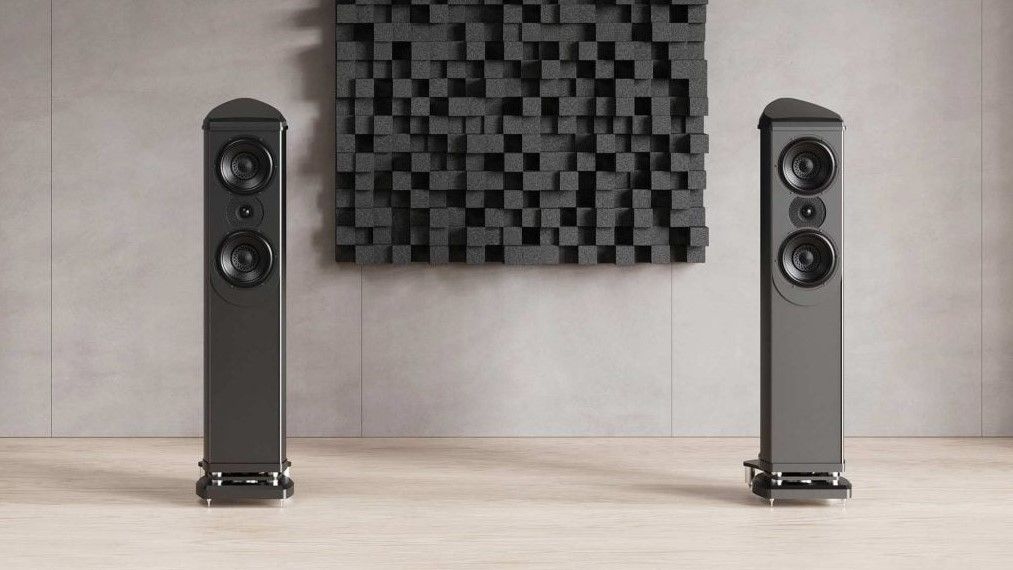
We're celebrating all things British hi-fi this week on What Hi-Fi?, so we had to include our updated round-up of our favourite sets of speakers to have emerged from our modest little island.
This list includes some big, some small, some heavenly high-end, some much more affordable – but all straight from the top draw when it comes to performance-per-pound value. There's also a lot of history here, with our rundown going back to the early '80s and then running all the way through to speakers built within the last few years.
What's clear is that the hi-fi industry has been - and continues to be - spoilt with British engineering talent, as you can see for yourself from the following list of superlative hi-fi speakers. From pioneering Wharfedales to ever-dependable ATCs, British hi-fi has produced some absolute gems.
- What Hi-Fi? launches British Hi-Fi Week 2024 – fresh reviews, retrospectives on classic amps and more
Wharfedale Diamond I (1982)
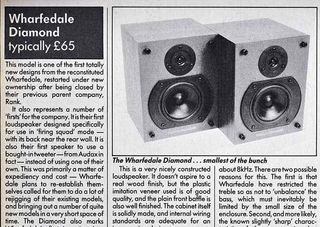
The original Wharfedale Diamonds were the seeds for what has become one of the most successful speaker ranges of all time and that, in itself, is a deeply impressive legacy.
While speakers these days come in more shapes and sizes than ever before, these pint-sized efforts stood at just 24cm high and were designed for those who needed a speaker to fit into a tight space. Hi-fi isn't always seen as something "for the masses", but the Diamonds made that musical, insightful Wharfedale sound accessible to practically everyone, not just those lucky few pulling in substantial salaries.
The handsome little units had a particularly praiseworthy midrange and bass considering their budget price, though they were slightly fussy in terms of partnering kit, working better with more upmarket amplification. With tuneful lows and musical highs, the Wharfedale Diamonds paved the way for one of the most successful British speaker ranges of all time.
Heybrook HB1 (1983)
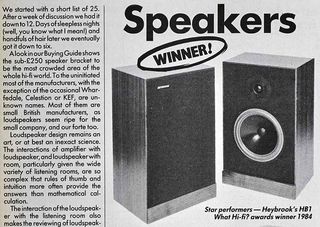
Heybrook was a British hi-fi manufacturer that started life in 1978 and was named after Devon's Heybrook Bay, which was near the site of the company's original factory. It's no longer around in its original form, but the legacy of the HB1 is enough to keep the name alive well into the 21st Century.
Get the What Hi-Fi? Newsletter
The latest hi-fi, home cinema and tech news, reviews, buying advice and deals, direct to your inbox.
Heybrook got off to a flying start after its inception, though, with the Peter Comeau-designed, entry-level HB1s proving a highlight of What Hi-Fi?'s early years. It was the first product to win three What Hi-Fi? Awards in a row, and that's a tricky thing to do even today. Not many products manage to even nab a single one.
With a sealed box design, they worked well when positioned close to a wall or surface, but what made them special was the fact that - thanks to a high-quality finish and dynamic sound - the HB1 were another example of a speaker that could hold its own against much more expensive efforts.
Acoustic Energy AE1 (1988)
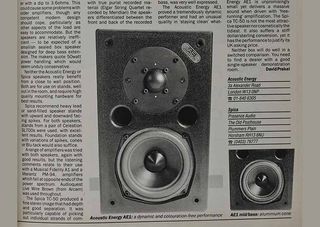
Acoustic Energy's AE1 were also smaller speakers whose performance belied their rather restricted size. They were capable of impressive punch and dynamic reach - in part thanks to their metal drivers, which were rare at the time.
They also weren't limited to one decade, evolving over several years and several variations to inspire what is today one of our favourite active speakers, the suitably-named AE1 Active, a former What Hi-Fi? Award-winner that owes a great deal of its sonic character to the fun, excitement and rhythmic sharpness of the 1988 speakers.
Epos ES11 (1991)
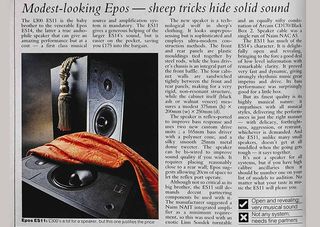
We enter the 1990s with Epos' ES11, which were similar in sonic character to the legendary ES14 but available for a fraction of the price. A win-win for both the speakers and the consumers, then.
As was usual for the brand, the crossover was minimal – it employed a single capacitor for the tweeter – helping them produce surprisingly sturdy bass and excellent resolution, in addition to superb rhythmic drive and dynamic expression.
A modest-looking but really musical pair of speakers, they could deliver just the right amount of aggression, delicacy and restraint as a song demanded, earning them a place on this list with ease.
Monitor Audio Studio 20 (1992)
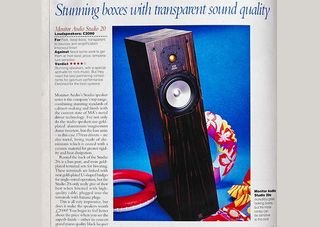
The Studio 20 were, back in 1992, one of the most detailed-sounding speakers we'd ever encountered. They've got that classic, old-school look, too, consisting of a large wooden profile with a couple of drivers plonked at the front of the cabinet, yet the whole thing just seems to work from an aesthetic, as well as audio, perspective.
They needed some fine-tuning and a fair bit of running-in thanks to those metal drivers but, these issues aside, they were incredibly well-finished and sounded terrific, treating listeners to transparency and clarity that very few rivals could contend with.
It was no surprise that their successors, the new-and-improved Studio 20 SE, arrived a few years later and occupied our test rooms as our reference model for many years. We sometimes miss them...
Mission 753 (1992)
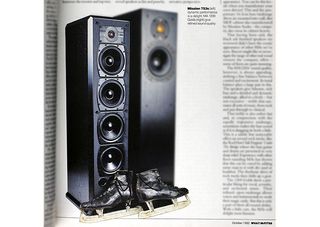
The 753 were an important speaker in Mission's history, ushering in a new slim floorstander design no wider than an, erm, ice skate. If you don't believe us, just see the picture above.
Both looking and sounding the business, they had a smörgåsboard of drive units with four 13cm drivers – two mid/bass drivers, two low bass units – and a single 25cm dome tweeter, through which a fast and punchy sound ensured whatever they were playing was enjoyably involving. They may have been slender and unassuming, but the sound they delivered was anything but anaemic.
Tannoy Mercury M2 (1997)
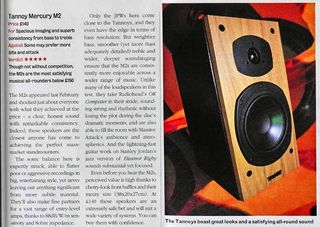
The Mercury M2 made an immediate impression when they burst onto the scene in the late 1990s. Back then, we said they were the closest anyone had come to creating the perfect mass-market standmounter, and we stick by that assertion as we look back at the M2 with only slightly rose-tinted spectacles.
Quite frankly, our ears hadn't heard a more satisfyingly musical all-rounder at their price of £150, so it's hardly surprising that we called them "an extremely safe bet (that) will suit a wide variety of systems". Yes, £150 doesn't get you as much these days thanks to inflation, but these were some of the best-value all-rounders you could ever hope to find back in 1997.
Wilson Benesch A.C.T. One (1999)
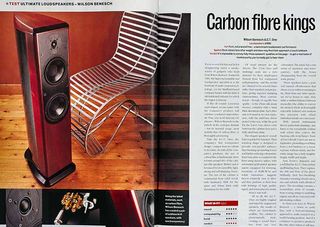
Five years after launching its first product, the Wilson Benesch Turntable, the British company launched a second: the A.C.T. One speaker.
Unveiled at the 1994 Frankfurt High End show, the floorstanders were made mostly out of carbon fibre (like many Wilson Benesch speakers after them), introducing the world’s first curved carbon fibre composite panel in a speaker design. That distinctive shape helped to reduce the build-up of internal standing waves, while the speakers' eponymous acronym (which stands for "Advanced Composite Technology") meant a combination of carbon fibre, wood and metal coming together to give class-leading rigidity and resonance control.
It all paid off. These superbly engineered and elegant-looking towers were the most analytical and musical speakers we'd heard before the turn of the century.
Read the full Wilson Benesch A.C.T One review
Quad ELS 2805 (2008)
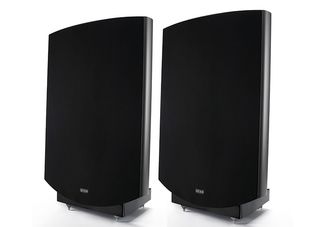
This side of the millennium we have the Quad ELS 2805. After all, it would be sacrilege to not include one of the British company's legendary electrostatic speakers in this list. So here it is.
"Fifty years after its electrostatic speakers first wowed the hi-fi world, Quad breaks new ground," we said of the 2805 in 2008, marvelling at a pair of speakers that felt innovative and cutting-edge at the time.
These one-way speakers (meaning there was no crossover in the signal path) fired equal amounts of sound backwards and forwards, so care was needed when setting up. Any bother was well worth it, though. The lack of punch and slightly lumpy bass were drawbacks, but in every other way, they were truly exceptional performers.
Read the full Quad ESL-2805 review
B&W 800 Diamond (2012)
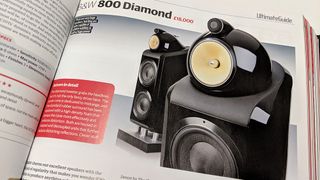
Continuing the high-end trend, these £18,500 speakers represented the pinnacle of B&W's cutting-edge technology back in 2012: "The ultimate expression of all the company’s trademark technologies," as we wrote in our original review . This has since manifested itself in the latest Diamond range.
From tweeter domes made out of diamond, to cleverly braced and shaped cabinets, to cones made out of Kevlar, they were innovative speakers that at the time showcased unrivalled clarity, dynamic reach and volume. The bass was stunning, as was the detail, and all of this sound was delivered with speed and kinetic punch.
Read the full B&W 800 Diamond review
KEF LS50 (2012)
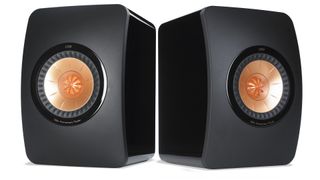
The KEF LS50 were, and remain, blindingly good speakers. They've won multiple What Hi-Fi? Awards over the years and have recently formed the basis of active versions in the shape of the LS50 Wireless II and LSX, as well as the passive LS50 Meta – all three What Hi-Fi? Award winners themselves.
Of course, a hat tip deserves to be directed to KEF’s trademark Uni-Q array (an aluminium dome tweeter in the centre of a magnesium/aluminium–coned mid/bass), which was largely behind the LS50's insightful and musical, bassy yet balanced sound.
Read the full KEF LS50 review
Neat Iota (2012)
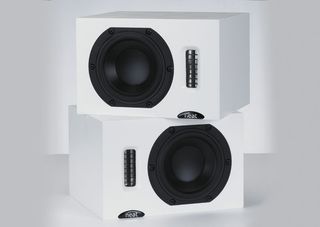
He who dares wins, right? With a sideways orientation that makes them look more like an AV centre channel speaker than a pair of stereo speakers, the 13cm-tall Neat Iotas were certainly different, but brilliantly so.
The Teesside-based speaker company's unusual design allowed us to experiment using them with the tweeters placed on the inside or outside, the latter of which we preferred. The Iotas sounded remarkable - big and bold, with plenty of detail, weight and scale on offer. And their tiny-boxed design only added to their appeal.
Read the full Neat Iota review
Q Acoustics Concept 20 (2013)
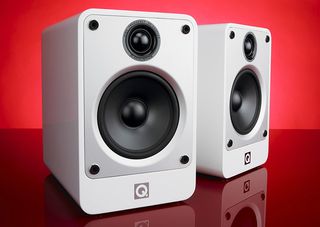
The strength of the competition at this price is always fierce, but it speaks to the talents of Q Acoustics' Concept 20 that they remain firm favourites even after more than ten years in the game.
The Concept 20 utilise what is still some of the company's top-tier technologies, such as the complex cabinet design that sees two layers of MDF separated by a lossy Gelcore material in an effort to dampen resonances. Thanks to such innovative engineering, they produce a multi-talented, all-round sound that delivers everything from punch and attack to subtlety and precision.
Budget speakers are worthy of just as much praise as super high-end ones, especially if they deliver on the promises they make at their more modest level. As their multiple Awards have demonstrated, the Concept 20 are one of the bargains of the decade.
Read the full Q Acoustic Concept 20 review
PMC Twenty 26 (2014)
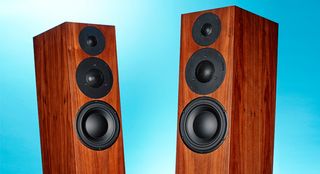
Speakers from PMC’s Twenty range have not only been winning awards in recent years but also occupying our test rooms.
Few rival floorstanders are as musical or as balanced as the Twenty 26, whose strong dynamics, impressive detail, even tonality and seamless integration are hard to find fault with. These may not be the latest models in the Twenty range, but they are among our favourites, demonstrating the British brand's commitment to engineering innovation and consistent quality across the board.
While more Recent PMC speakers, such as the Prodigy 1 and Prodigy 5 models, have demonstrated the brand's capabilities at the lower end of the market, we still have a huge soft spot for the Twenty 26 floorstanders.
Read the full PMC Twenty 26 review
Spendor SP2/3R2 (2016)
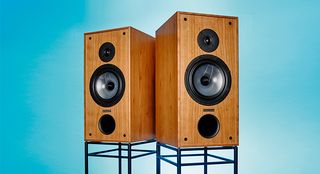
It'd be easy to dismiss Spendor's SP2/3R2 as a retro throwback, but that would be to miss out on a stellar speaker that very much deserves the attention of anyone with this budget. "Despite a design ancestry that dates back to the 1970s, there’s much this dinosaur could teach its modern competition," we noted in our 2016 review.
Sonically, they're huge, with a scale and authority that's made for epic blockbuster soundtracks. Yet there's absolutely no shortage of dynamics or detail either, and while they don't deliver the last word in punch or drive, rhythms are delightfully measured and controlled. If you favour a smooth, refined yet deeply insightful presentation, the SP2/3R2 remain a high point for British hi-fi.
Read the full Spendor SP2/3R2 review
ATC SCM 50 (2019)
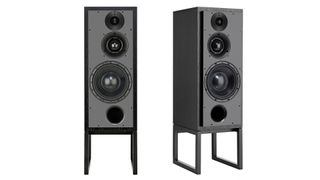
We’ve been using ATC’s SCM50 as our reference speakers for well over a decade, and in that time they’ve been connected to just about every piece of electronics that has passed through our test rooms. And guess what? They've never let us down after all these years, rewarding us time and again with the sort of reliability and dependable quality you'd normally see reserved for your pet labrador or favourite pair of slippers.
Every so often we come across rival speakers – usually of higher cost – that better these ATCs in some respect, whether it’s outright resolution, openness, stereo imaging or rhythmic precision.
Yet we haven’t managed to find something that’s as satisfying an all-rounder or as practical to use as a day-to-day review tool. Considering the SCM50 was originally introduced in the mid-80s, that’s quite some achievement. It seems great engineering doesn’t age after all.
Read the full ATC SCM 50 review
ProAc Response D2R (2019)
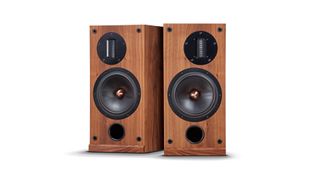
Don't let the lack of curved cabinets or fancy cone materials fool you. The ProAc Response D2R are among the finest speakers we've ever heard and are more than worthy of their spot on this list. They were What Hi-Fi? Award-winners in 2021, after all, with our expert test team hailing them as being "as insightful and entertaining as any speakers at this level". High praise indeed!
You'll need suitable stands, suitable electronics and the patience to spend a suitable amount of time tinkering with positioning, but once you've got those elements sorted, these exceptional standmounters will deliver an intoxicating mix of detail and entertainment that is very tough to beat at this price. They're also very easy with partnering and beautifully made, making them a pair of all-rounders that won't let you down no matter the situation.
Read the full ProAc Response D2R review
PMC Fact Fenestria (2022)
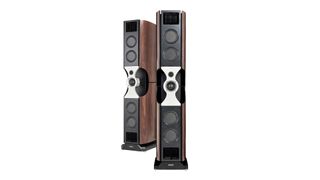
The PMC Fact Fenestria might be one of the tallest speakers to have been through our test rooms; they're also one of the best speakers we've heard. We liked them so much that they unanimously won the Best Temptation Award in 2022 – high praise indeed.
Yes, they're very expensive, but they were designed as an opportunity for PMC to take a fresh look at every part of loudspeaker design and come up with engineering solutions that are as free from budget constraints as they can be. Highlights include a lot of decoupling of the driver units from the baffle (and the cabinet itself) and implementing techniques used in skyscrapers to mitigate the swaying motion for the construction of its tall cabinets. It has clearly worked, too; these speakers deliver an awe-inspiring sound that simply demands to be heard.
The Fenestrias deliver sound with a deeply impressive impartiality, handling all genres of music with balance and precision, along with a deep, powerful bass that's never strained nor loose. These are big speakers so you can expect scale, dynamism and authority to match, all delivered with an incredible sense of realism and accuracy.
Read the full PMC Fact Fenestria review
Wilson Benesch A.C.T. 3Zero
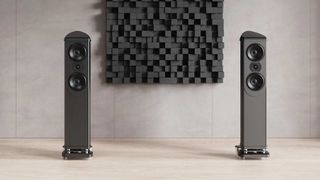
Wilson Benesch’s speakers are usually quite something to behold. We used the original A.C.T. One as part of our main reference system in the past, and it's been so gratifying to see the One’s exceptional DNA running through the quite incredible A.C.T. 3Zero floorstanders.
The 3Zero make use of the One's pioneered curved cabinets, a shape which diminishes the build-up of internal standing waves within the speaker, alongside a biocomposite developed as part of a pan-European research project with €7.4million worth of EU financial backing. That all gives the 3Zero superb rigidity and dampening, proving that Wilson Benesch is still keen to push the engineering boundaries in a bid to eke out as much performance potency as possible.
We could go (and have gone) into even greater detail regarding the speakers' impressive Fibonacci hybrid tweeters, 3D printed faceplate or isotactic polypropylene-coned crossover, but what matters to us is how the 3Zero sound. As we stated in our review, they deliver music "in a full-throttle manner", treating you to thrilling dynamic swings complemented by power, punch and precision alongside some of the most insightful and natural sound we've ever heard from a floorstanding speaker.
For us, testing the A.C.T. 3Zero wasn't a job or a chore; it was an experience.
Read the full Wilson Benesch A.C.T. 3Zero review
MORE:
11 of the best British turntables of all time
12 of the best British stereo amplifiers of all time
What Hi-Fi? launches British Hi-Fi Week 2024 – fresh reviews, retrospectives on classic amps and more
Why the 1970s were the perfect time to start a British hi-fi company
Read all our British Hi-Fi Week 2023 news, features and reviews
Becky is the managing editor of What Hi-Fi? and, since her recent move to Melbourne, also the editor of Australian Hi-Fi magazine. During her 10+ years in the hi-fi industry, she has reviewed all manner of audio gear, from budget amplifiers to high-end speakers, and particularly specialises in headphones and head-fi devices. In her spare time, Becky can often be found running, watching Liverpool FC and horror movies, and hunting for gluten-free cake.
- Kashfia KabirHi-Fi and Audio Editor
- Harry McKerrellSenior staff writer
-
Lefizz ReplyWhat Hi-Fi? said:To celebrate British Hi-Fi Week we've rounded up some of the best speakers from the British talent pool since the early '80s.
17 of the best British speakers of all time : Read more
Seriously disappointed the KEF Coda 7 isn't on this list. Absolute era defining speaker for me. -
Dbglobal How could they have left out one of the most Iconic British speakers ever made, the Rogers LS3/5a's. Makes you wonder who made up this list?Reply -
wpcheadle agree with Dbglobal...how can you leave off a 50 year old design still being made today?Reply -
HifiMusicMan Living Voice: Air partner, Tone Scout, Vox OlympianReply
Carfrae: Big Horn, Little Bog Horn
Lowther; just about everything they ever made in their exceptionally long history!
Who put your '17 'list together? Have they ever heard any of the above truly great British loudspeakers which will outperform everything on your list? -
Hifiman The comments are proof, as if proof were needed, that the list needs to be longer than 17! My personal addition would be Mission 70 Mk2s. After over 35 years I’m still impressed by them over contemporary speakers. Now that’s longevity.Reply -
djh1697 The Diamonds from 1983 where my first pair of speakers! They were a little bright with my Mission Cyrus 1, a NAD 3020 killer, from the same era. In time I upgraded to a pair a Tannoy Mercury M2's. These where both pleasant speakers. I now have a pair of Kudos X3's, which replaced a pair of Neat Motive 2's, which I am surprised haven't appeared in your list? Perhaps they don't have a large advertising budget with your magazine?Reply -
Renfrew Reply
I heard the Rogers Studio 2 speakers around 1983 and they were compared to much more expensive B&W speakersDbglobal said:How could they have left out one of the most Iconic British speakers ever made, the Rogers LS3/5a's. Makes you wonder who made up this list?
Needless to say the Rogers were faster and just more present for the lack of a better word.
They can handle 500 Watts RMS and weigh about 100 lbs. each. No they aren't gorgeous but what a sound. I'm still enjoying them. -
hybridauth_Facebook_10154385452764420 Reply
The LS3/5a was an attempt to make a Goodmans maxim bookcase speaker churned out in the millions, made of chipboard covered in vinyl sound good enough as a nearfield monitor, here at the BBC. The trade off was a very complicated and power hungry crossover burning up it's resistors with the too loud bits of the sound, and allowing the bits that weren't getting heard to remain! Rogers and Kef provided the drivers, as the EMI offerings in the Maxim, from Celestion weren't particularly efficient or well enough damped. As a bookcase speaker, they were impressive. Next to the LS5/8 with it's 16inch bass driver and huge cabinet, they sound pityful. The irony being the LS3/5a was later made under licence by Celestion and Goodmans. forgoing Rogers and KEF drivers, but staying true to the Vinyl and Chipboard, that other manufacturers messed up by changing. If you want to listen to a truly remarkable speaker try the 5/8 and 5/9 it's half pint cousin. They get better as they grow up! But the 5/8 became a Harbeth that totally eclipses the spendor SP series.Dbglobal said:How could they have left out one of the most Iconic British speakers ever made, the Rogers LS3/5a's. Makes you wonder who made up this list? -
hybridauth_Facebook_10154385452764420 Reply
770Hifiman said:The comments are proof, as if proof were needed, that the list needs to be longer than 17! My personal addition would be Mission 70 Mk2s. After over 35 years I’m still impressed by them over contemporary speakers. Now that’s longevity.
